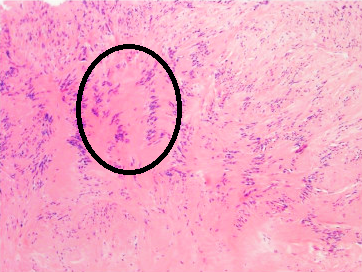Verocay Bodies on:
[Wikipedia]
[Google]
[Amazon]
 Verocay bodies were first described by Uruguayan neuro-pathologist
Verocay bodies were first described by Uruguayan neuro-pathologist
 Verocay bodies were first described by Uruguayan neuro-pathologist
Verocay bodies were first described by Uruguayan neuro-pathologist José Juan Verocay
José is a predominantly Spanish and Portuguese form of the given name Joseph. While spelled alike, this name is pronounced very differently in each of the two languages: Spanish ; Portuguese (or ).
In French, the name ''José'', pronounced , ...
in 1910. It is a required histopathological
Histopathology (compound of three Greek language, Greek words: 'tissue', 'suffering', and ''-logy, -logia'' 'study of') is the light microscope, microscopic examination of Tissue (biology), tissue in order to study the manifestations of dis ...
finding for diagnosing schwannoma
A schwannoma (or neurilemmoma) is a usually benign nerve sheath tumor composed of Schwann cells, which normally produce the insulating myelin sheath covering peripheral nerves.
Schwannomas are homogeneous tumors, consisting only of Schwann cells ...
s (tumor
A neoplasm () is a type of abnormal and excessive growth of tissue. The process that occurs to form or produce a neoplasm is called neoplasia. The growth of a neoplasm is uncoordinated with that of the normal surrounding tissue, and persists ...
s of Schwann cell
Schwann cells or neurolemmocytes (named after German physiologist Theodor Schwann) are the principal glia of the peripheral nervous system (PNS). Glial cells function to support neurons and in the PNS, also include Satellite glial cell, satellite ...
s).
Verocay bodies are a component of "Antoni A" which are the dense areas of schwannomas located between palisading spindle cell In neurobiology, spindle cell refers to:
* Spindle neuron, also known as a von Economo neuron
In general medicine, a spindle cell may refer to
the spindle-shaped cells that are found in certain types of tumor:
* Inflammatory fibroid polyp
* P ...
s found in neoplasm
A neoplasm () is a type of abnormal and excessive growth of tissue. The process that occurs to form or produce a neoplasm is called neoplasia. The growth of a neoplasm is uncoordinated with that of the normal surrounding tissue, and persists ...
s. Two nuclear palisading regions and an anuclear zone make up one Verocay body.
Originally Verocay bodies were called 'neuromas', a term coined by Louis Odier in 1803. The name changed to ‘neuro-fibroma’ under Von Recklinghausen and later in 1935 to ‘neurilemmomas’ under Arthur Purdy Stout
Arthur Purdy Stout (1885–1967) was an American surgeon and pathologist.
Early years and education
Arthur Purdy Stout was the fourth son of Joseph and Julia Frances (née Purdy) Stout. He attended the Pomfret School and Yale University, where he ...
. When Harkin and Reed coined the term 'schwannoma' in 1968, Verocay bodies received their present-day name.
Features on histopathological examination include:
1. Eosinophilic
Eosinophilic (Greek suffix '' -phil'', meaning ''eosin-loving'') describes the staining of tissues, cells, or organelles after they have been washed with eosin, a dye commonly used in histological staining.
Eosin is an acidic dye for stainin ...
acellular area due to overexpression of lamin
Lamins, also known as nuclear lamins, are fibrous proteins in Intermediate filament#Type V – nuclear lamins, type V intermediate filaments, providing structural function and Transcription (biology), transcriptional regulation in the cell nucle ...
s.
2. Consisting of reduplicated basement membrane
The basement membrane, also known as base membrane, is a thin, pliable sheet-like type of extracellular matrix that provides cell and tissue support and acts as a platform for complex signalling. The basement membrane sits between epithelial tis ...
and cytoplasmic processes.
References
Oncology {{oncology-stub